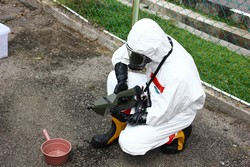Europe’s resilience to threats gets better
Several improbable hazard-related disasters on a mass population scale are becoming increasingly possible, particularly those involving CBRNE materials. Successful CBRNE resilience requires a global system-of-systems approach where all countries can collaborate to overcome threats. In addition, the possible proliferation of the knowledge on the use of chemicals as warfare agents to terrorist organisations also poses a threat. ‘Although CBRNE incidents in the “civil security” environment were considered “low probability”, global conflicts and the use of chemical weapons have also strengthened the case for developing CBRNE resilience,’ the project coordinator points out. The EU-funded EDEN(opens in new window) (End-user driven demo for CBRNE) project sought to overcome this challenge with a ‘toolbox of toolboxes’ and was unique by not presenting ONE solution (as it might be understood from the term “toolbox of toolboxes”, but rather presented a wide array of solutions. With the CBRNE market being fragmented, “one size cannot fit all”. There is a need to provide a range of solutions for the different users to choose. Having a “resilient response” means you have a team that is well trained, has the right tools and is confident in their use. This is exactly what the “EDEN legacy” is all about. ‘It provides end users with available comparable solutions and expertise with over 270 tools in the EDEN catalogue. These range from basic tools through to systems, toolboxes, i.e. collections of tools, human expertise and knowledge, standard operating procedures and a new CBRNE training framework.’ explains the project coordinator. This couldn’t have come at a better time also in the EU civil sector. The capabilities of the EDEN solution extend to radiological, chemical, biological, explosive and terrorist threats. ‘EDEN has tools dealing with detection, decontamination, personal protective equipment, medical care, imaging and transfer of data, command and control and other pivotal aspects to cover needs of end users in the preparedness, response and recovery,’ the project coordinator assures. EDEN has also demonstrated that current EU food regulation does not enforce the food companies and operators to comply with any procedure to prevent and to detect deliberate contamination. A panel of end users evaluated EDEN’s tools, ascertaining enhanced CBRNE resilience from threat assessment to recovery through three pivotal themes: food defence, multi-chemical and radiological. This involved demonstrations in food processing plants, industrial and hospital response environments, and a large-scale radiological test demo. Over 300 end-users and observers have been involved in the 15 EDEN demonstrations and over 100 tools/systems have been evaluated. Stakeholders can now benefit from a common framework that enables access to the latest products and services, as well as to secure real-time exchange networks. The project has also promoted the establishment of food defence standards that should be implemented at EU level. Project results are already being exploited, and a number of tools are being further developed in complementary EU-funded projects. An example of this is a new light detection and ranging technology real-time evaluation of surface microbial contamination to valuate surface cleanliness before, during and after decontamination which is being further developed in another DG HOME project. EDEN has significantly advanced CBRNE capabilities, many of which offer commercial exploitation opportunities. The new online EDEN CBRNE training framework was developed with the aim of launching a new European standard. Law enforcement authorities, food producers, researchers and policymakers will be in a better position to identify the sector’s vulnerabilities and define prevention and mitigation strategies.



